INTRODUCTION
Social exclusion is a phenomenon associated with the dynamics of a process of consolidation of deprivations. One of the characteristics that distinguishes the exclusion of poverty is, precisely, the understanding of the former as the result of a trajectory and not of a state. Thus, while poverty can be understood as a photo, exclusion would be better represented as a movie.
Economic crises are disturbances on the different dimensions of the economy and the social aspect is not exempt. The COVID-19 pandemic generated one of the deepest economic crises across the globe, its effects on the well-being of populations are indisputable. In the difficult context that emerged around the pandemic, concern about its effect on poverty and social exclusion took center stage on the political and social agenda. The differentiation of the concepts of social exclusion and poverty has generated deep discussions in the literature and their confusion is common in less specialized fields.
In this context, the work exposes a theoretical discussion on poverty and social exclusion and, in turn, due to their shared origin, tries to measure the multidimensional deprivations in Argentina before and after the measure of Preventive and Compulsory Social Isolation established in the framework of the health crisis. To fulfill the objective, a conceptual-theoretical review is outlined and the aggregate multidimensional deprivation indicator proposed by Ibáñez Martín (2018) is estimated for the years 2019 and 2021.
The empirical work does not find an increase in the amount of deprivation suffered by Argentine society after the COVID-19 pandemic. However, a process of deepening existing privations is evident. In other words, this work would make it possible to argue that after the health and economic crisis experienced in 2020, the least favored individuals are in a more serious situation.
However, due to the effect that the isolation measures have had on the information gathering process, this paper does not estimate the incidence of the pandemic on social exclusion.
DEVELOPMENT
Theoretical framework
The last decades of the 20th century have been marked by increasing global macroeconomic instability (Rapoport and Brenta, 2010). In Latin America, this panorama was accompanied by great difficulties for the construction of a political-institutional order that could face the restrictions imposed by the transformations that were evident in economic matters in the rest of the world. In this way, the succession of dictatorial periods, the debt crises and the stagnation of economic growth consolidated a discouraging landscape for the region. This situation had its effect on the social fabric, which was profoundly transformed (del Cueto and Luzzi, 2008; Rama, 1986; Serrano, 2010). It is within this framework that, from the field of social sciences, new approaches were proposed that could account for the specificity of the phenomena observed during the period (Boccardo, 2013; Delfino, 2012). Thus, a deeper discussion arose regarding the scope of the concept of poverty and a literature that began to explore the use of the concept of social exclusion as an overcoming alternative for the study of the social issue.
The first approaches proposed for the conceptualization and measurement of poverty were postulated in a unidimensional way, mainly attending to income as a relevant dimension when determining the condition of poverty. In this way, individuals in a condition of poverty will be those who do not obtain an income that allows them to pay for access to certain goods and services defined as basic to have a dignified living condition. The literature referring to poverty measurements that are based on this approach corresponds to the indirect method, since the satisfaction of needs is not directly evaluated, but rather the potential to achieve this based on income is considered. The advantages of the method are related to the low information requirements necessary to carry out the estimates. However, the one-dimensional perspective of the phenomenon is contested because it omits the existence of other relevant dimensions, with a partial or limited approach to the deficiencies faced by people living in poverty (Nolan and Whelan, 2010).
The capabilities approach provided a theoretical framework that made it possible to overcome the limitations evidenced by the one-dimensional vision (by income) of poverty. Within it, poverty is conceived as a state of deprivation of basic capabilities that limits the freedom of the affected people to choose between different courses of action and lifestyles (Sen, 1999). This way of characterizing the phenomenon introduced a change in the relevant evaluation space for its study; Income began to be outlined as a means for development and not an end1. Consequently, education, health, participation, work, among others, were incorporated as relevant dimensions (Ibáñez Martín, 2018). The diffusion of this approach to conceptualize poverty resulted in numerous efforts aimed at achieving the construction of indicators that managed to capture the multidimensional aspect of the phenomenon (UNDP, 2000; Alkire, 2016).
The introduction of multidimensional poverty measures in Latin America occurred in the 1980s, with Chile and Argentina being the pioneer countries in the matter, thanks to the contributions of Kast and Molina (1975) and the measurements carried out by INDEC (1984). These advances were based on the application of the Unsatisfied Basic Needs method proposed by ECLAC. More recent studies apply Alkire's double counting method -Foster (2011)-AF onwards- to obtain poverty estimates in Argentina (Mitchell and Macció, 2018; González and Santos, 2020; Fares et al., 2021). Santos and Villatoro (2018) take the FA methodology and, in order to improve its applicability in Latin American countries, propose modifications in its operationalization that is mainly reflected in the introduction of new indicators and threshold values. Following this line, González and Santos (2018) make and compare estimates for Posadas, the Argentine Northeast region (NEA) and the country as a whole.
The concept of social exclusion, for its part, is far from having a single definition and clear limits regarding what makes a person excluded. Starting in 1990, the use of the term began to spread widely, which had originated two decades earlier in France (Rubio, 2016). In this period, the results of the processes of change in labor relations began to become evident, a process that Castel (1997) called “the crisis of the wage society”. Employment lost its role as an integrating axis and enabler of full citizenship, it had an impact on the living conditions of the population, increasing the levels of insecurity of the middle and lower social strata. The corollary of this metamorphosis was the proliferation of new social problems, with a degree of complexity that exceeded the explanatory capacity of the pre-existing theoretical categories. In this way, the formulation of the concept of social exclusion arose to overcome the theoretical vacuum originated in the transformations of the social structure resulting from the processes of globalization (Saraví, 2006).
In the literature there are multiple definitions of social exclusion. The agreements around its exact meaning and the applications it has are still partial, which exposes the need to move towards a succinct and precise description that condenses the particularities of the phenomenon. Laparra et al. (2007, p. 27) point out that in the original conception postulated by the French sociological tradition, exclusion is understood as the "social process of loss of integration that includes not only the lack of income and the distance from the labor market, but also a decrease in social participation and therefore a loss of social rights”. Following this same line, Estivill (2003, p. 19-20) describes it as "an accumulation of confluent processes with successive ruptures that, starting from the heart of the economy, politics and society, distance and "inferiorize" people, groups, communities and territories with respect to the centers of power, resources and dominant values”. The treatment given to the concept by a series of authors (Estivill, 2003; Gallie et al., 2003) leads to it being operationalized as a phenomenon of accumulation of disadvantages (Saraví, 2020), which implies the presence of cumulative processes of deprivation presented in various relevant dimensions for the integration of the individual in society.
This last definition implicitly reveals the multidimensional nature of social exclusion, that is, the existence of multiple spheres in which deprivations can occur that shape the exclusionary process. The dimensions can be relatively autonomous but their interaction gives rise to trajectories that feed back and deepen the level of deprivation experienced by individuals (Silver, 2007). The multidimensionality of the phenomenon is recognized by numerous authors (Room, 1995; Atkinson and Hills, 1998; Burchardt, 1998; Sen, 2000; Subirats et al., 2005; Laparra et al., 2007; Hernández Pedreño, 2008) and, in general, the degree of agreement around this characteristic is high. The relative nature of the exclusion is also highlighted (Golovanevsky, 2003; Castells, 2004, Ibáñez Martín, 2018), which introduces the need to consider the space-time in which the population of interest lives. Thus, the definition of relevant dimensions and thresholds from which the existence of deprivations is recognized cannot be independent of the society and the moment in time that is being considered. Lastly, when postulating the existence of exclusive trajectories or «processes», the dynamic nature of the phenomenon is alluded to. In this way, it is recognized that exclusion does not constitute a state in which the individual finds himself, but a succession of deprivation situations that develop over time2 (Ibáñez Martín, 2018).
Recognizing the multidimensionality of the phenomenon implies the need to define precisely which are the relevant dimensions in the excluding process; they will vary over time and between communities, taking into account the special characteristics of the populations of interest, due to the relative nature of the exclusion. For this reason, an extensive list of areas that must be taken into account can be found in the literature. Within this list, those around which there is greater consensus stand out and are frequently used in various works: the economic dimension (Minujín, 1999; Estivill, 2003; Raya Diez and Hernández Pedreño, 2014), labor, educational (Jiménez Ramírez, 2008; Hernández Pedreño, 2010), health (Barnes, 2002; García Chacón et al., 2017), politics (Laparra et al., 2007), housing conditions (Raya Diez, 2007) and social (Subirats et al., 2004; Berkman et al., 2007). The most recent works also incorporate the dimensions: digital, perception, environmental, among others (Ibáñez Martín, 2018).
Based on the conceptual presentation made in the preceding paragraphs, a series of similarities between poverty and social exclusion can be appreciated, which has given rise to questions regarding the contribution that this last conceptualization makes to the study of social phenomena. The multidimensional treatment of poverty introduced from the capabilities approach implies considering deprivations as the origin of the phenomenon and recognizing that these are not limited to the purely economic sphere, but that there are more spheres that are revealed as determinants of the trajectories of the poor individuals. This is a meeting point with the concept of social exclusion, since it also refers to the presence of deficiencies in various dimensions as a cause of the exclusionary process. Based on this similarity, critical positions arise from the exclusion approach, considering it only a change in the terminology used to name a phenomenon that, in essence, is the same as that captured when talking about poverty (Oyen, 1997).
However, it is possible to find differences between both concepts that justify the use of one term or another to refer to situations that are dissimilar. The dynamic nature of the phenomenon of exclusion is one of them: while poverty is conceived as a state, when referring to the problem of social exclusion we are referring to a process (Madanipour and Shucksmith, 2015). On the other hand, it also highlights the fact that, even when poverty is conceived as a multidimensional phenomenon, the empirical treatment of relational issues is not addressed (in most antecedents). Social exclusion, on the contrary, incorporates the role of relational factors as central to the process that gives rise to deprivation (Ibáñez Martín, 2018). Sen (2000) establishes that it is precisely the possibility of emphasizing relational issues that allows the concept of exclusion to represent an advance in the analysis of social problems. Poverty, for its part, has its main focus on the distributive aspect (Jehoel-Gijsbers and Vrooman, 2007).
Continuing with this line of argument, it is possible that there are situations in which there are people who are excluded, but are not in a situation of poverty, or who are poor, but are not excluded. Despite being different concepts, using them in a complementary way can lead to a more precise characterization of social reality.
Empirical analysis
Data and variables
In order to assess social exclusion, it is necessary to have information for the construction of thresholds and reference groups, and also to be able to follow individuals over time. In the Argentine case, the Permanent Household Survey meets the requirements, but limits the possibility of measuring certain dimensions and the use of certain thresholds. The EPH has been applied in Argentina since 1973 and is carried out in 31 urban agglomerates throughout the country. It is currently held throughout the year and provides information for each of the four quarters. Its application is on households, these being individuals or groups of people, whether related or not, who live under the same roof and share their food and/or other essential living expenses (INDEC, 2018). Regarding the monitoring of households/individuals in the EPH, the set of households to be surveyed is renewed periodically. This scheme affects the precision of the estimates of the change between two different periods and of the estimates obtained by adding the sample, while at the same time allowing errors due to panel fatigue to be reduced and thus a reduction in the level of non-response.
The overlapping of the samples in the EPH follows the following scheme: the household is surveyed for two consecutive periods (in the week and month assigned for the area in which it is located); for the two following quarters, the household in question is not surveyed; then, they are reincorporated into the sample to be surveyed for another two quarters. This rotation scheme allows a temporary analysis to be carried out since a home can be monitored over a year and a half.
The selection of dimensions and thresholds is made based on the literature on deprivation, poverty, vulnerability and exclusion (Mendicoa and Veneranda, 1999; Gomez, 2001; Paz, 2002; Barnes, 2005; Pantazis, Gordon and Levitas, 2006; Sojo and Rica, 2006; Arévalo and Paz, 2015; Santos, 2016; Santos and Villatoro, 2018; Gutierrez, 2017; Etcheverry, 2017; Nolan, 2017; Cantillon, Gábos, Goedemé, and Tóth, 2018). Additionally, the choice seeks to adapt to the criteria that Ayala Cañón (2006) highlights as desirable: they must capture and synthesize the essence of the problem, they must have sufficient normative content so that an increase in deprivation is easily identifiable.
According to Sen (2000) exclusion can be analyzed as the persistence of failures to function and, therefore, it is a deprivation in the capacities of individuals. Atkinson and Hills (1998) argue that exclusion can be seen as chronic and relative deprivation in terms of functioning. Thus, the criterion in the selection of the dimensions (and their thresholds) pursues the objective of measuring exclusion under this conception.
The dimensions and thresholds that can finally be used for empirical measurement in Argentina are delimited and limited, shown in Table 1.
Within the dimensions, two types of treatments can be distinguished: hierarchical dimensions, where the degrees of deprivation can be ordered and the most severe level of deprivation is assigned with a higher number, and dimensions of an additive type, in those where the value of the dimension is built by adding deprivations in various aspects. In these dimensions, higher values indicate a greater number of aspects in which the individual is deprived. For example, an individual who verifies deprivation in all aspects covered by the economic dimension will have a value of 5 assigned to it. The maximum number of deprivations that an individual could verify under this scheme is 30.
Table 1 Dimensions (and thresholds) of social exclusion for Argentina based on EPH
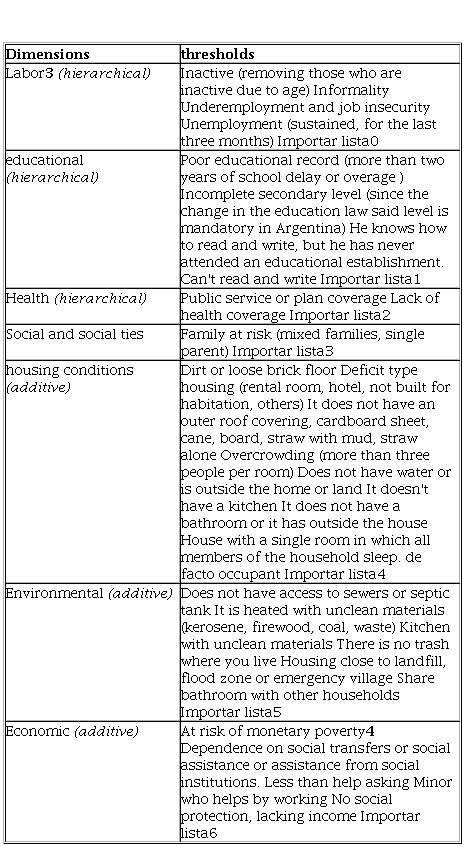
Note. Own elaboration based on Ibáñez Martín (2018)
As can be seen from Table 1, the database has certain limitations. In particular, there are no instruments that make it possible to capture the dimensions of participation, self-perception and digital divide. Additionally, there are limitations regarding variables related to health. However, the EPH is the only database in Argentina that would allow for a dynamic, relative, and multidimensional analysis of exclusion.
Regarding the thresholds, it is worth noting that some of them contain the others. For example, if a person cannot read or write, then they will verify a more acute level of deprivation in the educational dimension than someone who has not been able to complete secondary school (but who should have done so due to their age); but the first condition implies the fulfillment of the second. In this sense, the thresholds try to capture the aspect of nuances or degrees of exclusion: the people in the previous example will verify deprivations in the educational dimension and should be targeted by educational policies, however, the magnitude of the deprivation is substantially different. The objective of the thresholds is to contemplate the highest degree of deprivation of people, so that greater or more acute deprivation will be counted when calculating the indicators.
On the other hand, it is recognized that certain dimensions or thresholds are not conditions specific to the individual, but rather to the home to which they belong. In this case, the deprivation level verified by the household will be assigned to each component of the household. In turn, certain deprivations must be modified based on the age of the individual for whom the indicators are calculated. For example, a ten-year-old child will not have a value in the labor dimension, but will be affected by the condition of his parents in relation to the labor market (which will condition the economic, health, and housing dimensions, among others).
As previously detailed, in order to measure exclusion it is necessary to have follow-up of individuals. However, due to the measures taken within the framework of the COVID-19 pandemic, the EPH for the second quarter of 2020 was carried out by telephone instead of in person. The result of this modification was a high non-response rate that led to the fact that the information from 15 agglomerates (out of a total of 31) did not meet the minimum requirements established by INDEC for its dissemination (INDEC, 2020). .
The monitoring of households has been put at risk due to the methodological change in the collection of information, making it impossible to estimate social exclusion. For this reason, in this work only situations of deprivation before and after the COVID-19 pandemic will be estimated. Additionally, since the recomposition of the EPH survey with the traditional methodology, there is not the number of periods necessary to assess the persistence of deprivations and, with it, the follow-up of individuals and households over time. These issues are, among others, the limitations to assess the situation of social exclusion in Argentina after the COVID-19 pandemic.
Methodology
In order to carry out the estimation of deprivations, the individual deprivation index proposed by Ibáñez Martín (2018) is used. It is calculated for the periods 2019 and 2021, using data from the Permanent Household Survey (EPH) of Argentina.
The outbreak of the pandemic caused by the appearance of the COVID-19 virus resulted in the adoption of preventive measures by governments around the world. In Argentina, the health policy that governed as of March 20, 2020 provided for the strict and mandatory isolation of the inhabitants, excepting from it only those who were considered essential workers (workers in the area of health, security, defense and personnel of industries strategies for supplying the population). The limitation of mobility prevented the productive activities of numerous sectors for a long period of time; In this framework, the possibility arises that the deprivation situations experienced by individuals have worsened. The choice of the years 2019 and 2021 responds to the objective of evaluating whether there was indeed an impact on the living conditions of the country's inhabitants from the sanitary measures implemented.
The deprivation indicator proposed by Ibáñez Martín (2018) is built through an axiomatization process. First, an indicator of malfunctions is proposed that captures the existence of deprivations in different dimensions relevant to the development of social life: economic, labor, educational, health, social, housing, and environmental. The indicator is defined as the sum of all deprivations experienced by the individual weighted by the relative importance of each dimension in the set of deprivations analyzed5, that is:
where pi,x indicates the degree of deprivation of individual i in dimension x and ax is the weight that accounts for the relative importance of dimension x in the set of deprivations analyzed.
Under this logic, an individual is deprived in a certain dimension if it does not exceed an established desirable threshold value. However, within each sphere there can be different intensities of deprivation and therefore the individual's failure to function will be different depending on the number of dimensions in which he is deprived and the degree of deprivation that he verifies. For example, in the indicator of malfunctions, an individual who has not completed primary education will have a higher deprivation value than the other individual who has not completed secondary education, thus reflecting the greater degree of severity of the lack experienced by the former.
The individual deprivation index is constructed from the indicator of operating failures, defined as:
is the set of individuals that show profiles of malfunctions with fewer deprivations than i and is defined as
is the set of individuals that present greater deprivations than i and, analogously, is defined as
One of the main criticisms of quantitative indicators on social phenomena is the abstraction of their construction. Although the deprivation index is a quantitative construction, with its limitations, it incorporates the comparison of the individual with respect to their environment by taking into account the sets of agents that present higher and lower levels of deprivation. In this way, elements of subjectivity are introduced into the determination of the degree of deprivation and the estimates do not rest solely on objective parameters determined by the researcher. The latter is due to the purpose of capturing the feeling of alienation of the subjects who go through the exclusionary process, in order to recognize the relative and relational nature of the phenomenon.
The index calculated for an individual i will take higher values the larger the set of agents that experience fewer malfunctions than i and the better the relative situation of the set with respect to the individual in question. Consequently, a subject can present a low level of malfunctions and, nevertheless, experience a high degree of deprivation if they find themselves in a situation that is relatively worse than that evidenced by the rest of the relevant population. This behavior of the indicator aims to incorporate the feeling of alienation that characterizes excluding processes.
In the subsequent stages of the axiomatization process, the dynamic aspect of the exclusionary phenomenon (expressed through the persistence of deprivations) is incorporated to compose an individual indicator of social exclusion and, finally, an aggregate index measure is constructed for the total of the population under analysis. In the present work, estimates of these last indicators are not exposed due to the existence of limitations in the comparability of the data required to carry out the corresponding computations.
Results
As detailed in the methodology, the first step in assessing deprivation at the individual level is to identify the degree of failure to function for each individual. The results of the estimations of the individual indicator of malfunctions are shown in Table 2.
Table 2 Malfunctions at individual level 2019-2021
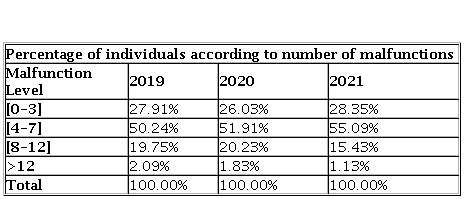
Note. Own elaboration based on information from EPH.
As can be seen, more than 70% of the population shows at least 4 malfunctions during the entire 2019-2021 period. It is worth highlighting a downward trend in the proportion of individuals who present a high level of deprivation (that is, they experience 8 or more malfunctions in the dimensions considered) and a concentration of deprived subjects around more moderate levels. The participation of individuals who accumulate between 4 and 7 simultaneous malfunctions is greater than 50% of the population and presents a sustained growth throughout the period considered, reaching values 10% higher in 2021 than those observed for 2019.
Based on what is observed in Table 2, the year in which the COVID-19 pandemic occurred and in which stricter isolation measures were taken does not seem to have generated a considerable increase in the degree of deprivation of the Argentine population.
It is interesting to analyze what happens within each of the dimensions contemplated in the conformation of the indicator of malfunctions. Regarding the hierarchical variables, that is, the labor, educational and health dimensions, it is found that the dimension in which the highest levels of deprivation are concentrated is labor: more than 50% of the population experiences the more severe levels of malfunctions. This proportion increases during the year 2020 due to a growth in the number of underemployed individuals and employees in precarious conditions; however, it presents a slight recovery in 2021, stabilizing around values close to those observed in the year prior to the outbreak of the COVID-19 pandemic (Table 3).
Table 3 Malfunctions in hierarchical dimensions 2019-2021
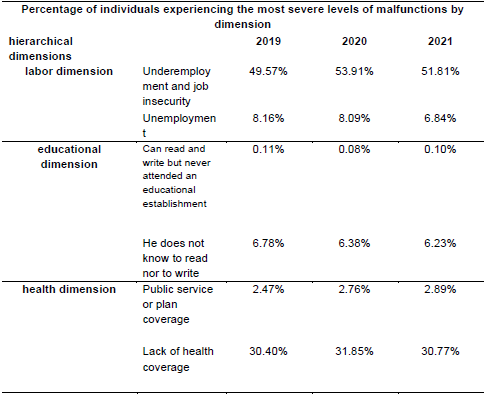
Note. Own elaboration based on information from EPH.
Regarding the educational dimension, the percentage of individuals who show the two most severe levels of deprivation remains close to 7% and shows a slight decrease throughout the period, mainly explained by the decrease in the level of illiteracy. Finally, it is found that a minority fraction of the population uses public health services, however, there is a growing trend in the participation of this type of benefit. It is noteworthy that 30% of individuals experience the highest degree of deprivation in the health dimension, due to the complete lack of coverage. This participation increases slightly in 2020 and decreases again the following year. Thus, from the results shown in Table 3, it can be deduced that the labor dimension is the one that is most sensitive to episodes such as COVID-19, while the variation in deprivation in the dimensions of education and health does not seem considerable.
Table 4 shows the results for the additive dimensions: economic, housing and environmental.
There is a strong presence of economic deprivation, where the risk of monetary poverty and aid dependency are the most recurrent deficiencies among the Argentine population throughout the period analyzed. It is worth noting that in 2020 there is an increase in both deprivations and in the economic dimension in general. However, this dimension shows a recovery towards 2021, reaching values below pre-pandemic. A relevant characteristic is that during the year 2020, where the preventive isolation measures were longer and more demanding, there was a greater dependence on aid. By 2021, a decrease in this deprivation is observed, however, to analyze post-pandemic behavior, a longer period of time must be available.
Table 4 Malfunctions in Additive Dimensions 2019-2021
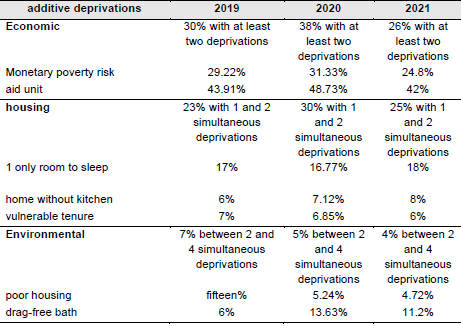
Note. Own elaboration based on information from EPH.
Regarding the housing dimension, simultaneous deprivation is not a severe problem (dimension with 9 indicators), although it is observed that approximately a quarter of the population shows at least one housing deprivation. The most frequent deficiency is related to the existence of a single sleeping environment (excluding families made up of 2 members who declare to be a couple or spouses), reaching levels close to 17% in the three periods analyzed. Vulnerable tenure and not having a kitchen are deficiencies that affect approximately 7% of the population. Housing deprivation shows an increase in 2020 and a subsequent recovery. Finally, a small number of Argentine men and women suffer from simultaneous environmental deprivation. The most recurring deprivation is the proximity to garbage dumps, villas and floodplains and, secondly, the lack of drag in the home bathroom. This deprivation shows a decreasing trend in the three years analyzed.
Thus, from the results presented in Tables 3 and 4, it is found that in the period analyzed, the failures to function are strongly led by the economic and labor dimensions, while the other dimensions show slight simultaneous deprivations. These results are in line with other precedents that evaluate multidimensional deprivations for Argentina (Zamanilo et al., 2005; Salvia et al., 2015; Ibáñez Martín, 2018; Ibáñez Martín & London, 2018).
According to various studies, deprivation is distributed unequally among the population, with social groups existing in relations of domination. In this sense, the relative participation of women and of the different regions of the country in the failures of functioning is analyzed. Table 5 shows the case of the regions.
The Northwest and Pampeana regions are the ones that concentrate the highest proportion of population with malfunctions.
Table 5 Relative participation of Argentine regions in malfunctions 2019-2021

Note. Own elaboration based on information from EPH6.
In the temporal analysis, it is observed that the Greater Buenos Aires region loses general relevance in the accumulation of individuals with simultaneous deprivation, while the Cuyo and Patagonia regions become more important towards the end of the period. In particular, Cuyo appears as a region with relevance in the participation of individuals with the greatest accumulation of deprivations. Regarding deprivation in the year of the COVID-19 pandemic, the consequences seem to have affected the Cuyo and NOA regions more severely, which increased the relative participation in the distribution of individuals with deprivation. In the case of NOA, its participation has increased steadily since 2019. This process would be in line with the results found by González and Santos (2020) regarding the reduction of historical disparities between the north and the rest of the country.
When broken down according to the intensity of the fault, at low levels of deprivation a certain homogeneity is observed between all the regions, however, the Pampeana and NOA are the ones that accumulate the largest number of individuals with up to 18 simultaneous deprivations. Additionally, these two regions concentrate almost 50% of the most severe private events. The relevance of the Pampas region coincides with the findings of Gasparini, Gluzmann and Tornarolli (2019) regarding the regional distribution of chronic poverty.
Regarding the participation of women within the different levels of malfunctions, Table 6 shows that they are more exposed than men to the most severe multiple deprivations, a result that coincides with what was found for the phenomenon of poverty for Peace and Arevalo (2020).
Thus, the participation of women in deprivation levels that accumulate more than 4 simultaneous deprivations is always higher than the participation of men. Additionally, this situation to the detriment of women worsens throughout the years analyzed and the year 2020 appears to be a more detrimental moment for this group.
Table 6 Participation of women in malfunctions 2019-2021
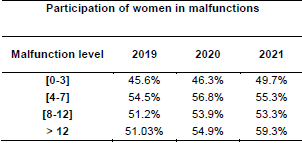
Note. Own elaboration based on information from EPH.
Finally, as has been mentioned throughout the work, the conditions that lead to situations of social exclusion are affected by the relative and relational aspects of the phenomenon. Thus, any indicator that is included in the attempt to assess the social exclusion of a society must incorporate some aspect of comparison to consider the feeling of alienation. This treatment is addressed in the individual deprivation indicator. The results of this index are shown in Table 7.
Table 7 Individual deprivation indicator 2019-2021
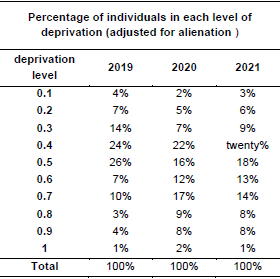
Note. Own elaboration based on information from EPH.
From Table 7 it can be seen that, by incorporating the feeling of alienation from the comparison with the rest of the population, the deprivation levels rise with respect to what happens in the indicator of malfunctions. Thus, approximately 50% of the population perceives a level of deprivation between 0.4 and 0.6 while in the indicator of functional failures this percentage was concentrated only between 4 and 7 simultaneous deprivations. Additionally, it is observed that in the year 2020 there is an increase in the level of deprivation, values that decrease in the year 2021; however, they are higher than in the pre-pandemic year. This could account for a negative effect of the COVID-19 crisis on relative deficiencies; however, this conclusion should be strengthened by analyzing a longer period of time.
Finally, Table 8 shows the participation of women within each level of individual deprivation.
Table 8 Relative participation of women in each level of deprivation
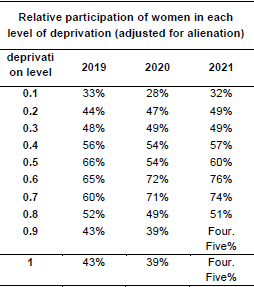
Note. Own elaboration based on information from EPH.
The relative participation of women shows a behavior similar to what happens in the indicator of malfunctions. The female sex is the protagonist in the moderate and high levels of deprivation, losing the leading role in the most severe levels (0.9 and 1). It should be noted that in the last two levels of the individual deprivation index there are very few observations, so this aspect must be approached with some care.
CONCLUSIONS
The existence of deprivations in multiple dimensions of social life is the shared origin of the phenomena of poverty and social exclusion. The latter is characterized by its relative, relational and dynamic nature and, therefore, the time dimension plays a central role in its evaluation. In turn, the dimensions that must be considered to analyze social exclusion must go beyond economic aspects and incorporate some threshold of comparison with what is considered necessary to be part of society.
From the analysis of the malfunctions carried out, it is found that the labor and economic dimensions are the ones that lead the process of social exclusion in Argentina for the years 2019, 2020 and 2021. Additionally, there is no evidence to sustain that the period of greater restrictions imposed by the COVID-19 pandemic has resulted in an increase in deprivation evidenced by the Argentine population. In the most severe malfunctions, women and the NOA and Pampean regions are the social groups with domination relationships, being the most affected by deficiencies in various dimensions.
One aspect that is under discussion regarding assistance policies is the dependency that they could generate in the receiving group. In the case of the aid dependency variable, although an increase is shown in 2020, the values return to the value of 2019 after the pandemic year. This result could show that the care measures taken during the year 2020 have not generated a situation of dependency, although it should be studied in a detailed manner with other estimation techniques in order to strengthen the conclusion outlined.
By incorporating the non-economic aspect, that is, the feeling of alienation, the individual deprivation indicator is obtained. This index reveals the relevance of the relational aspect of the phenomenon, since by including the comparison with the group of more and less deprived individuals, the individual deprivation levels are higher than those obtained by the index of malfunctions. The indicator also exposes the disadvantage of the female sex in the relative deprivation processes, where the relative participation in the most severe levels of deprivation is much higher than in the male case.
One result worth noting is that individual deprivations increased in severity (although not in quantity) in the period of the COVID-19 pandemic. Although in 2021 there is evidence of a decrease in the values of the individual deprivation indicator for more acute levels of deprivation, they have not returned to the values prior to the pandemic. This result must be strengthened with the most extensive temporal analysis, both back to 2020 and afterwards.
Some policy implications emerge from the results found that are worth mentioning. On the one hand, if the objective of the policy actions is to reduce the deprivation of the population and promote equity, then the measures should have a gender approach and a geographic focus on the most affected regions. On the other hand, the dimensions that seem to lead the deprivation processes are labor and economic, so policies on these aspects are essential to increase the level of well-being of the Argentine population. Additionally, the results show a state of deprivation more severe than that evidenced in the pre-pandemic period. This could show that families have not accumulated more deprivations, but that those already present have worsened. Thus, the focus of policies on the less favored sectors is an even more urgent need than in 2019.

















